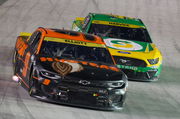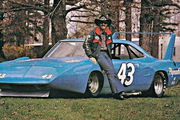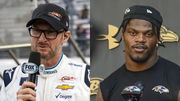

In a recent social media post, Joe Gibbs Racing (JGR) gave fans an inside look into one of NASCAR’s more curious practices—why the windshields of race cars are covered during inspections. For longtime NASCAR enthusiasts and casual viewers alike, this move may seem like just another part of the pre-race or post-race ritual. But as JGR revealed in a video uploaded to their Instagram page, in the words of Optimus Prime, there’s more to it than meets the eye. The video delves deep into the evolution of NASCAR’s inspection process, taking us on a historical journey from the sport’s early days to the cutting-edge technology used today.
For those who have ever wondered what’s behind NASCAR’s rigorous inspection protocols, this video breaks down decades of innovation, revealing why modern inspections are far more complex than just a quick look under the hood. As it turns out, the practice of covering windshields isn’t just for show—it’s a vital step in ensuring that every car meets NASCAR’s stringent technical standards.
ADVERTISEMENT
Article continues below this ad
A history of NASCAR inspections: From basic checks to high-tech lasers
Back in the 1940s and ’50s, NASCAR inspections were pretty straightforward. The focus was on basic components like engines, shocks, and fuel tanks, along with rudimentary safety features. There weren’t many ways to cheat the system, so inspections were quick and relatively simple. But as racing technology advanced, so did the tactics that teams used to gain a competitive edge. This pushed NASCAR to introduce more rigorous inspection methods to keep the playing field level.
By the 1960s, inspections had evolved to include basic templates to check a car’s dimensions. As teams became more creative in manipulating car shapes for aerodynamic advantages, the templates got increasingly complex. These templates became a staple of NASCAR inspections throughout the ’70s and ’80s. However, things took a significant leap forward with the introduction of the fourth-generation car in 1992. This was the first time NASCAR implemented highly modified body panels to ensure teams stayed within the rules. Inspectors began using templates all over the car’s body to make sure it conformed to NASCAR’s shape standards.
The inspection process continued to evolve, and in 2003, NASCAR introduced a common template to standardize car bodies across manufacturers. Teams now had to conform to a unified set of dimensions, which was intended to level the playing field. However, this still allowed for some flexibility, leading to cars that were flatter on one side and more curved on the other—often called “twisted sister” setups.
That all changed with the fifth-generation car in 2007, which was designed to eliminate those lopsided designs. NASCAR introduced a massive, claw-like template that would fit over the car, ensuring that no part of it was out of alignment. Fast forward to 2013, and NASCAR upped the ante once again with the sixth-generation car, incorporating laser inspections alongside the traditional templates.
But it wasn’t until 2018 that NASCAR fully embraced cutting-edge technology with the Optical Scanning Station (OSS), also known as Hawkeye. This high-tech system uses extremely precise lasers to scan the entire car, detecting even the slightest deviations from the allowed dimensions.
Trending
What’s your perspective on:
Does NASCAR's high-tech inspection process ensure fairness, or does it stifle team creativity and innovation?
Have an interesting take?
Why cover the windshield? The role of the Optical Scanning Station (OSS)
So, why do teams cover the windshields during inspections? The answer lies in the capabilities and limitations of the OSS system. The Optical Scanning Station uses lasers to measure the car’s shape and dimensions with incredible accuracy, but there’s one catch—the lasers can’t scan through transparent surfaces like glass. This means that if the windshield and rear window were left uncovered, the lasers would pass right through them, making it impossible to get an accurate reading of the car’s dimensions.
By covering the windshield and back window with an opaque material, teams provide a consistent surface for the lasers to scan. This ensures that every car is measured accurately, leaving no room for hidden modifications or tweaks that could offer a competitive advantage. According to Joe Gibbs Racing, the use of these covers helps ensure a fair and level playing field for all competitors.
The OSS system has revolutionized how NASCAR ensures compliance with its rules. It’s a far cry from the early days of quick visual checks and basic measurements. With the OSS, NASCAR can detect even the smallest deviations, forcing teams to bring their cars to the track in perfect compliance with the rulebook.
ADVERTISEMENT
Article continues below this ad
View this post on Instagram
This high-tech approach has caught many teams off guard, leading to some notable penalties in recent years. For example, in 2022, Joe Gibbs Racing’s own Denny Hamlin and Kyle Busch had their finishes stripped at Pocono Raceway after their cars failed post-race inspections due to dimensional infractions. Despite their initial 1-2 finish, both drivers were disqualified, handing the win to Chase Elliott.
ADVERTISEMENT
Article continues below this ad
As technology continues to evolve, so will NASCAR’s inspection process. With the introduction of the Next Gen car, the sport is embracing even more advanced materials and engineering. The Next Gen car’s design, which includes a composite body and a new suspension setup, offers new challenges for teams and inspectors alike. NASCAR is likely to continue refining its inspection protocols to keep up with these changes.
The use of the Optical Scanning Station is just one example of how NASCAR is leveraging technology to maintain the integrity of the sport. As fans, we might not always see what goes on behind the scenes, but every covered windshield and every scan is part of a broader effort to ensure fair competition. So the next time you see a car being inspected with its windshield covered, you’ll know it’s not just a formality—it’s a key step in keeping NASCAR’s playing field level.
Have something to say?
Let the world know your perspective.
ADVERTISEMENT
ADVERTISEMENT
ADVERTISEMENT
ADVERTISEMENT







Does NASCAR's high-tech inspection process ensure fairness, or does it stifle team creativity and innovation?